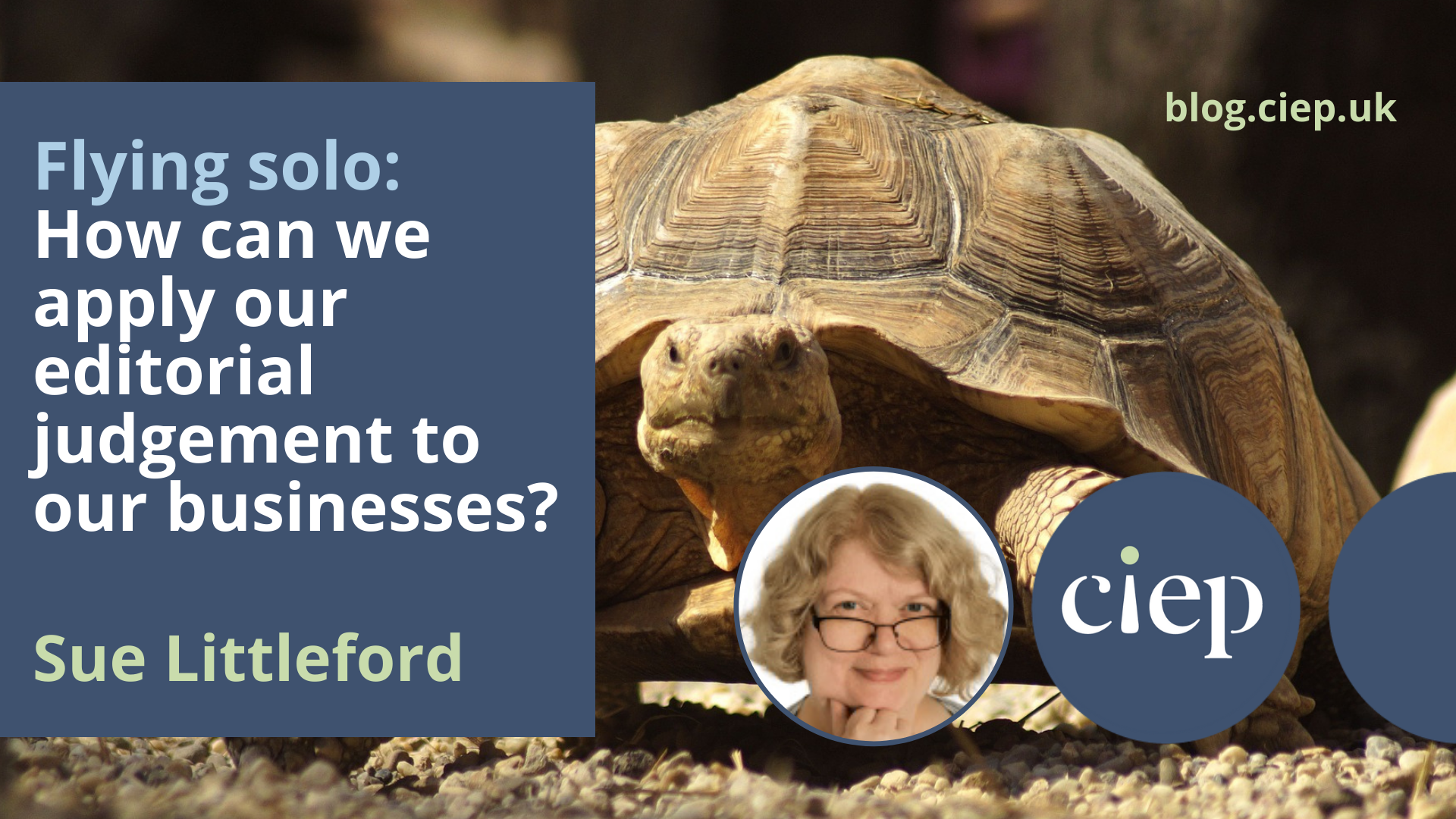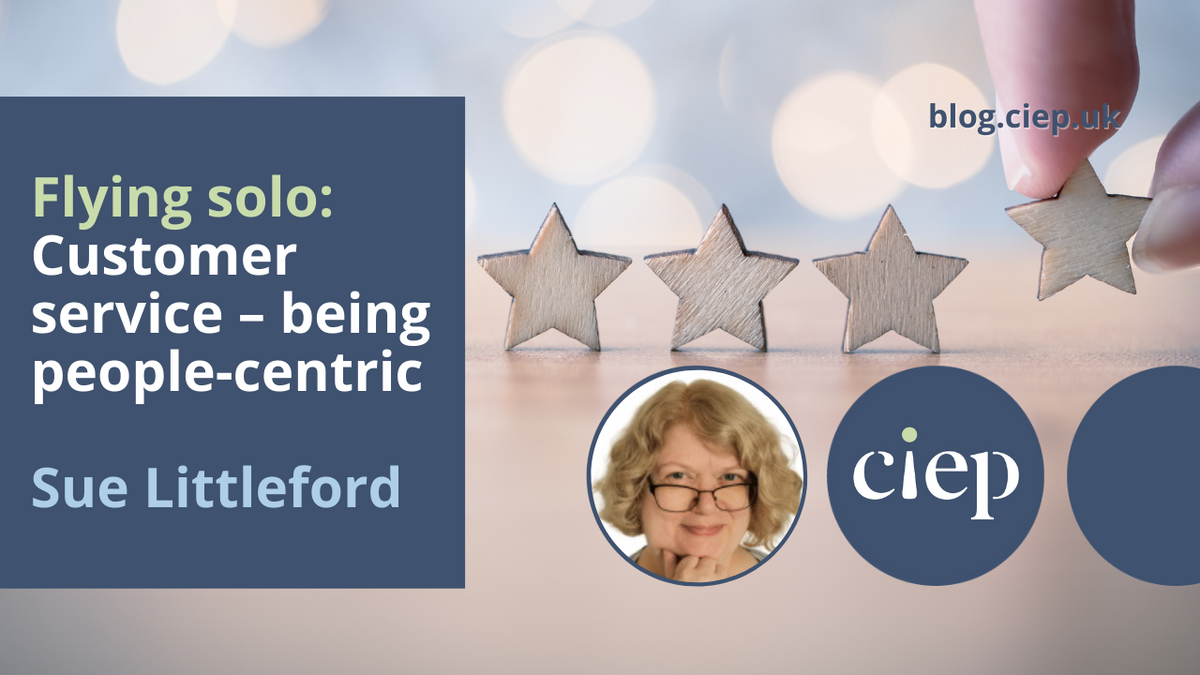In this Flying solo column, Sue Littleford makes the case for why training and continuous professional development are vital for editors and proofreaders – considering their importance to CIEP members in particular.
Members of the Chartered Institute of Editing and Proofreading (CIEP) understand the emphasis put on training and the acquisition of the appropriate level of skills, as well as maintaining and expanding them through continuous professional development (CPD).
The CIEP distinguishes between core skills and editorial skills, core skills being about how to edit or proofread, and editorial skills being more about the context in which the editing or proofreading takes place and expanding your skillset.
But why this emphasis on training? It’s there in the curriculum for professional development and in the upgrading system (members should take a look at How to upgrade your CIEP membership, especially chapters 2, 3 and 11 for all members, and chapter 4, 5 or 6 depending on the grade you’re working towards). Training is all over the forums! Advanced Professional Members (APMs) are required to show their commitment to CPD, to stay current with best practice.
Simply put, we don’t know what we don’t know.
We don’t know if – while we’ve been nose to the grindstone – new tools, new standards, or new and better approaches to the work have been developed and are now circulating. Training allows us the time to look up and look around, and see what’s happening out there.
Training also gives our clients the confidence that we do actually know what we’re doing, which is invaluable to them and to us. Members in the Professional grades can take out an entry in the Directory of Editorial Services, and potential clients searching the Directory will have confidence that members who have achieved Professional membership or higher have the backing of solid training.
But surely, I hear some of you cry, I already know what I’m doing! English isn’t evolving so quickly I can’t keep up all by myself. I don’t need additional training – I’m learning on the job all the time. I don’t need formal training – I pick things up as I go!
I say again: we don’t know what we don’t know.
Going on training courses that challenge you to do better expands your abilities and your experience and gives imposter syndrome a biff on the nose. And, as workshop training starts to become available again in some places, there can be the chance to meet other editors and talk together. Just talking to other editors about their contexts can be a real eye-opener.
Sometimes an absolute gem of a tip gets mentioned in the margins of a course, off-topic but really useful to you. Learning isn’t restricted to the course outline.
Some people prefer to learn on their own. Well, that’s fine, so far as it goes; but, especially if you’re still building up your experience as an editor or a proofreader, how do you know you’re learning what you need to know? Are you learning in sufficient breadth, with perspective? Or are you just burrowing further into your own snug editorial world, unaware of what you can learn from outside that niche?
If so, you’re really restricting the kind of material you can work on competently and, in these ever-uncertain days, that may be somewhat counterproductive for your business and your financial health.
Equally, some people have learned on the job by being tutored or mentored by their boss – or just by ‘sitting with Nelly’ as we used to call it in the civil service. That’s fine too, but to upgrade you’ll also need to sit and pass the CIEP’s editorial test (page 34 of the upgrading guide and on the website). Again, the CIEP’s emphasis in the test is on across-the-board competence. Niche away in the jobs you choose to take on, but don’t become isolated and narrow in your approach to your professional practice.
Getting a good solid grounding in the fundamentals of editing under your belt (and keeping it current) gives you a great springboard for developing yourself and your business in the way you want.
One of the characteristics that unites good editors is our curiosity, along with our quest for new knowledge (and a headful of otherwise useless bits and bobs of general knowledge). The ability to know when something we’re editing sounds off is of great value to our clients.
Maintain that inquisitive approach.
Record-keeping
Regular readers will know what a fan I am of record-keeping. It’s no different with training, which is why the Going Solo toolkit (CIEP members only) has a spreadsheet on which to record the training you’ve already undertaken, and the training you’d like to take.
Listing out the training you’ve already taken will help you see where you have weaknesses, or where your training is out of date and ripe to be refreshed.
Keeping a note of training courses you fancy the look of – the spreadsheet has a handy column to keep a link to each one – will whet your appetite and enable you to see whether anything you’ve taken note of neatly plugs a hole or tops up your training in that area.
Consulting the curriculum for professional development will also help you check whether you’re getting a rounded education as an editor or a proofreader. Looking at that curriculum will open your eyes to what it is you didn’t know you didn’t know. Add topics to your wish list so you can be on the lookout for courses to fill the gaps.
And if you’re still working through the CIEP’s grades, the spreadsheet was developed with the input of the Admissions Panel. Collecting the evidence is easy and you don’t have to copy out your training all over again on the upgrade form.
Planning and budgeting
Training costs time and it costs money. If you’re still working through the CIEP grades, then you’ll want to set aside a training budget each year – in cash and in time. If you’re already an APM, then you’ll set aside a CPD budget each year.
But how much money? And how much time? This is where the curriculum, the requirements of the grade you’re aiming for, the direction you’re taking your business in and your wish list of training courses come together.
Using all the information you have recorded on courses taken, gaps in training and your wish list, you can prioritise which course(s) to take next. You can then ensure you can afford them and set aside the time available to do them justice.
I know some inveterate course-takers who have huge plans and then, when they come to tot up the total cost and the time commitment, have to move some courses they’d love to do into the next year – or the next two years. Well, it’s nice to have something to look forward to!
Tax implications
For UK taxpayers, training is an allowable business expense for the self-employed in some cases only. If you pay tax elsewhere, check your own jurisdiction on this.
In brief, in the UK, training is not an allowable business expense if it’s undertaken to enable you to start trading.
Nor is it an allowable business expense if it’s undertaken to enable you to move into a new area of business. Harsh but true.
Training is an allowable expense if it keeps you up to date in your skills and knowledge. Even HMRC likes CPD!
Take note that, as with all other allowable expenses, training costs are only allowable if they are incurred wholly for business purposes.
This is the advice on the GOV.UK website:
Training courses
You can claim allowable business expenses for training that helps you improve the skills and knowledge you use in your business (for example, refresher courses).
The training courses must be related to your business.
You cannot claim for training courses that help you:
-
-
- start a new business
- expand into new areas of business, including anything related to your current business [my emphasis].
-
It’s made very clear that not all training is allowable.
The technical bit is in HMRC’s Business Income Manual.
Takeaways
- Training is a sound investment in yourself and your business, making you fit for purpose as an editor or a proofreader. It gives your clients confidence that you do actually know what you’re doing and will do it well. It also keeps you poised to move your business in a new direction if that’s something you want – or need – to do.
- Autodidacticism can work well, but can also come across as less authoritative and clients may feel less confident about your offer. Training supplied by reputable providers enhances your profile and ensures you don’t get in a rut.
- Learning on the job is also fine, but you will need to pass the CIEP’s online editorial test in order to upgrade.
- Training is also clearly set out in How to upgrade your CIEP membership as an essential pillar of every upgrade.
- Some training, but not all, is an allowable business expense to be deducted from your business’s profit to reduce your income tax and National Insurance contributions liability.
About Sue Littleford
Sue Littleford is the author of the CIEP guide Going Solo, now in its second edition. She went solo with her own freelance copyediting business, Apt Words, in March 2007 and specialises in scholarly humanities and social sciences.
 About the CIEP
About the CIEP
The Chartered Institute of Editing and Proofreading (CIEP) is a non-profit body promoting excellence in English language editing. We set and demonstrate editorial standards, and we are a community, training hub and support network for editorial professionals – the people who work to make text accurate, clear and fit for purpose.
Find out more about:
Photo credits: back to school by Olia Danilevich on Pexels; love to learn by Tim Mossholder on Unsplash.
Posted by Sue McLoughlin, blog assistant.
The views expressed here do not necessarily reflect those of the CIEP.

































